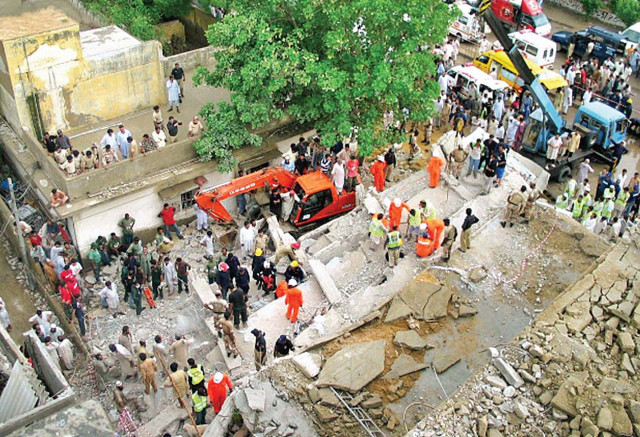For a pink palace, only the murkiest intentions surface

For a pink palace, only the murkiest intentions surface
Prince Mir Mehdi Raza Khan Talpur, the successor to the dynasty, has seen many a bureaucrat with intentions so excellent you would not need sugar to sweeten the tea over which his plans are discussed. These bureaucrats are perhaps incarnations of viziers from another era.
Fort and palace
The objects of interest in this case happen to be the Kot Diji fort and the pink-splendoured Faiz Mahal in Khairpur where the royal family lives. On Monday, members of the Sindh Assembly discussed the damage time and vandals have done these heritage sites and indignation mixed with hope for their restoration was expressed. MPA Sassui Palijo pegged the responsibility of the upkeep on the federal archaeology department. She said that her department had made many visits to the fort and wanted to set up a museum for its armoury. Similarly, they had approached the Talpur Mirs but the family had rejected offers to renovate the palace.
The chief minister said that he had personally asked the prince to hand over the palace to the government but instead the family had recommended the government give it the money to do it themselves. The CM said they would take the matter up with the Cabinet.
Reservation not conservation
There is a reason why Prince Mir Mehdi Raza is not enthusiastic about the government’s intentions. “What would a government engineer do to restore or repair the building of Faiz Mahal,” asked Talpur while speaking with The Express Tribune. “I have no problem with it, but Faiz Mahal is not like any other ordinary building out there that a local engineer can keep in shape.” As such, the structure of the building is not the worry, he said. It is the foundation. The water table level is going up, weakening the soil.
The cracks need to be properly filled with perhaps the soil-hardening methods that are available. “You cannot just fill them with cement or other substandard material being used in local construction,” he said, adding that all he was asking for was an internationally qualified expert who could examine the building and assist, given that heritage was at stake. Talpur also had something to say about the remark on Kot Diji Fort made by the chief minister. “It is already under the authority of the government,” the prince pointed out. “Why did they even mention it if they did not know its status.”
Efforts
It is not as if Talpur has ignored the fort. He has been forced to deploy guards to keep a check on vandals. “You go and see what they have done to the beautiful fort. They have replaced one or two main walls with concrete and cement. Who in the world would do such a thing to deform the original shape?” This is not the first time the Talpur family has been approached. According to the prince, each time someone comes to power, they approch the royal family with grand plans to preserve the castles and forts.
“Most of them want me to take the money and split it with them which is always the ulterior motive. I am not going to do that at any cost.” There are several ways to control the damage. Chemical conservation has been developed and is simpler and less expensive. “Why does the government want to spend so much money,” asked Talpur. He also questions why experts from India, who have experience conserving a similar heritage, are not consulted. Is it just because they are an “enemy nation”?
The prince does what he can. “Repair work, including that for paint, tiles, or filling the gaps is all cosmetic work,” he said. “I spent Rs20,000 to buttress a wall structure but it falls off after every four months. The problem is that the cement had a chemical reaction on the brick work and caused damaged to the anterior brick work.” It is not as simple as just slapping on mortar and hoping it will somehow hold.
From 1783 to 1830
Mir Sohrab Khan Talpur rebelled against the Kalhora dynasty, following the murder of his kinsman Mir Bahram Khan in 1775. He founded the state of Khairpur in 1783, following a long contest for the leadership of the Talpur clan. He then established his capital at Burahan, which he renamed Khairpur in 1786. Mir Sohrab Khan Talpur’s control extended northwards to Kashmore and Subzalkot (now in Bahawalpur), Mithankot (now in the Punjab), to Noushero Firoze in the south, and to the borders of Jodhpur in the south east by 1791. He divided his territories between his sons and invested his eldest son with full powers of administration in 1811.
He retired to Ahmadabad Fort, Diji. He joined forces with the Rais of Hyderabad in an attack on the remaining Afghan strongholds in Sindh. He defeated and expelled the Afghans from Shikapur in 1823, retaining joint control of the city and sole sovereignty over the areas north, east and west of the city. He died from injuries received after falling out of a window at the palace in Khairpur Mirs in 1830. A sprawling pink stone palace, the Faiz Mahal was built two hundred years ago and its furnishings have remained unchanged over the years.
The family crest is displayed prominently in the large, chandeliered reception hall. Portraits of the Mirs of Khairpur adorn the walls. Faiz Mahal is used for the family’s public interactions. Its faded glory is a reflection of the heydays of Khairpur State.
Published in the Express Tribune, May 27th, 2010.



















COMMENTS
Comments are moderated and generally will be posted if they are on-topic and not abusive.
For more information, please see our Comments FAQ